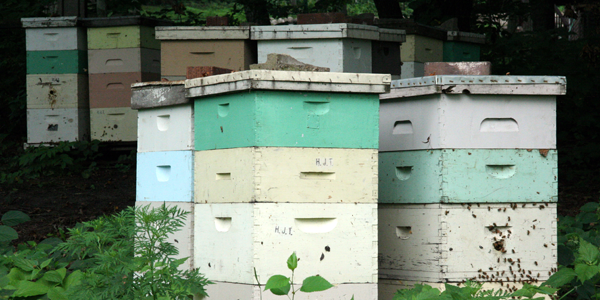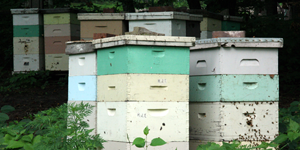A Honeybee Mystery: Science Reading
Readers of The Hive Detectives are treated to beautiful photographs and in-depth information about bees as they follow the path scientists took in tracking a global bee population crisis first identified in 2006.
Did you know that beekeepers keep beehives in stacked containers like the ones shown above? They look almost like sets of drawers! As you learn in The Hive Detectives: Chronicle of a Honey Bee Catastrophe, the layers of a hive are very orderly, and certain things appear and happen at different levels of the stack. When beekeepers check on the health of a hive, they often need to carefully examine each layer, one by one!
There may be thousands of honeybees in a single hive. But what happens when you lift off the top layer of the hive only to find that the hive is empty? What might cause such a problem?
This is exactly what happened to one beekeeper in 2006. He went to check on a set of hives and discovered thousands of his bees had disappeared. The Hive Detectives by Loree Griffin Burns tells the story of what turned out to be a global problem and a true mystery for scientists.
The Hive Detectives is a fantastic science-themed reading adventure for a student interested in environmental science, animals, or insects. The book tracks a science investigation with global impact, but is told in a way that brings together individual stories of beekeepers and scientists and makes the research accessible and interesting for middle readers. Plus, if all you know about bees is honey and the chance of getting stung, this book is eye opening!
In The Hive Detectives (part of the Scientists in the Field Series), readers meet a range of beekeepers and scientists who study mysteries like the one surrounding the decline in the honey bee populations. The story opens with an in-depth look at bees, beehives, and beekeeping. From a detailed explanation of the structure of hive boxes to brood nests, capped honey, and bee behavior, the opening pages give readers an inside look at the world of bees and set the stage for the next chapter, which chronicles the day in 2006 when Dave Hackenberg discovered that four hundred of his bee hives were inexplicably empty.
Thousands of bees had simply vanished, and slowly it became clear that the problem was not unique to Hackenberg. Instead, a global honeybee crisis was underway. As more and more beekeepers began reporting similar problems with their bees, scientists got involved in tracking the mystery and trying to find an explanation for what became known as "colony collapse disorder" (CCD).
The Hive Detectives does a great job weaving scientific detail and explanation (accompanied by clear, detailed, large, and full-color photos) throughout the story. With The Hive Detectives, students of all ages can learn more about bees, about the important role bees play in the ecosystem, and about the many kinds of science (both laboratory and field) that come into play when investigating a problem like CCD.
See also: The Case of the Vanishing Honeybees: A Scientific Mystery
Categories:
You Might Also Enjoy These Related Posts:
- Book list for science-filled summer reading!
- New Series of Science Buddies Books
- Look Up: Bird and Astronomy Summer Reading
- Blending Science and Art with Paper Inventions
- Special Effects Fun with Nick and Tesla
- Nick and Tesla Build a Gadget Glove: Science Reading
- The Most Magnificent Thing: Science Reading
- Do Even More with Your Raspberry Pi Projects Kit











